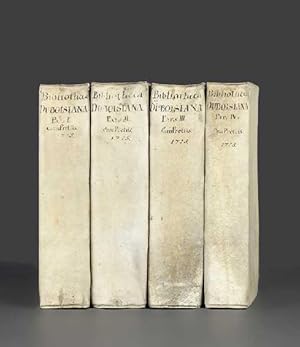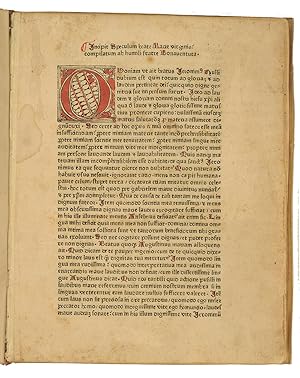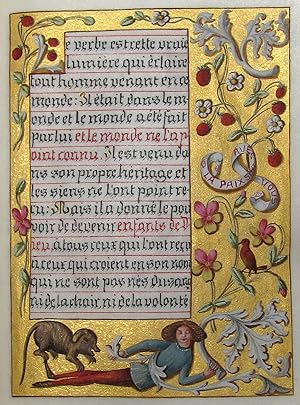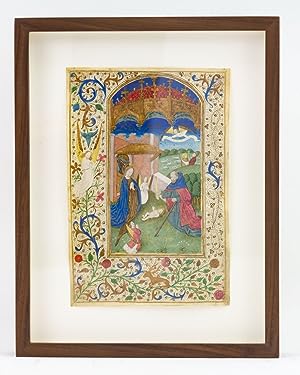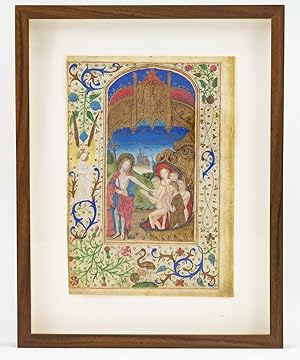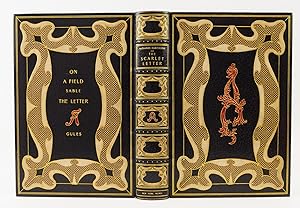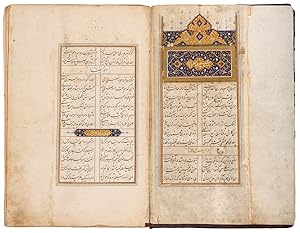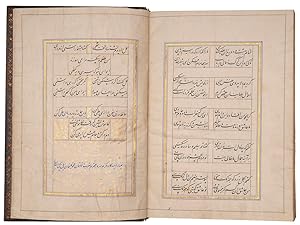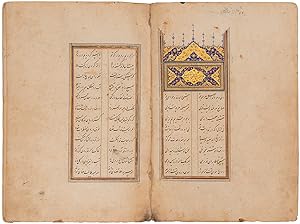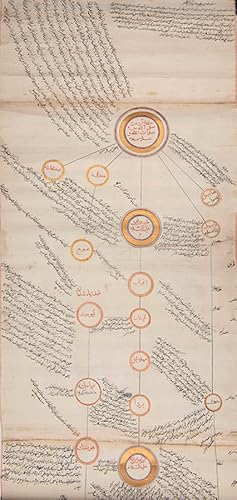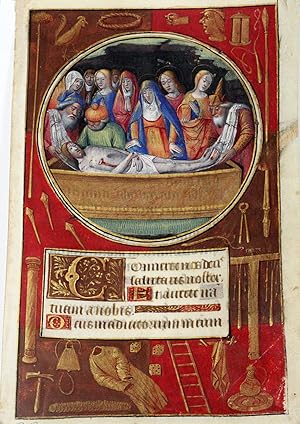Illuminated Manuscripts (Over 5,300 results)
Product Type
- All Product Types
- Books (4,887)
- Magazines & Periodicals (16)
- Comics (1)
- Sheet Music (1)
- Art, Prints & Posters (50)
- Photographs
- Maps (5)
-
Manuscripts &
Paper Collectibles (344)
Condition
Binding
Collectible Attributes
- First Edition (1,450)
- Signed (135)
- Dust Jacket (942)
- Seller-Supplied Images
- Not Printed On Demand (4,853)
Free Shipping
Seller Location
Seller Rating
-
Carta Executoria, granted by King Philip II of Spain, for Pedro de Segovia, with a fine contemporary portrait of the monarch, Renaissance manuscript in Spanish, on parchment
Published by Spain, 1562
Seller: Stephen Butler Rare Books & Manuscripts, Castlethorpe, PROVI, United Kingdom
Manuscript / Paper Collectible First Edition
Hardcover. Condition: Very Good. 1st Edition. 99 leaves (plus an endleaf at front), complete, collation: i22, ii46, iii31 (last three leaves blank cancels), ruled in red for single column of 34 lines of a formal Spanish vernacular hand, with ornamental penwork cadels to uppermost and lowermost lines, opening words of each section in ornamental capitals, initials in gold on burgundy grounds heightened with white scrolling acanthus leaves, one large historiated initial (14-lines in height) in gold foliate forms with a Classical dolphin at its foot and a human face on the outer edge of the bowl of the letter, enclosing a portrait of the monarch in ornamental gilt armour holding an orb and casually resting a sword on his shoulder, all on burgundy grounds decorated with clusters of white dots, four full-page miniatures profusely illuminated (arranged in two sets of facing pages at opening of volume), marginal ink-drawing on fol. 27v (perhaps Cain killing Abel with the jawbone of an ass), numerus contemporary endorsements at end filling up originally blank space there, slight cockling throughout, trimmed at top removing tips of some penwork cadels there, else excellent condition, 315 by 225mm.; contemporary binding of red velvet over pasteboards (composed of near-contemporary manuscript and printed waste), red silk pastedowns, boards bumped in places, velvet rubbed and with holes at extremities and spine Provenance: 1. In the same anonymous, and perhaps French, nineteenth-century collection as the Milanese Breviary of the fifteenth century now Morgan Library and Museum, M.209-210, a printed Franciscus de Retza, De generatione Christi, Speyer, Johann and Konrad Hist, 1484, once in the Ritman library and an etching of Vincent van Gogh, L'Homme à la Pipe, now in the BnF. in Paris. These all with a red ink stamp of 'ct' followed by a cross, all within a circle (recorded as Lugt 642d). Both the Morgan manuscript and the etching were subsequently in the collection of P.F. Gachet (1828-1909), a Parisian doctor who treated van Gogh in his last weeks. 2. Sotheby's, 4 December 2018, lot 178, for £9375, to Martin Schøyen, his MS. 5606, thereafter kept in his London library. Illumination: This is a sublime example of a Carta Executoria. The quality of the art of such commissions seems to have been set by the patron's standing and the amount of money they were prepared to put into the commission, and the artist here ranked among the highest of his peers. There are four full-page miniatures in a Mannerist style, and a portrait of the monarch as a grown man (Philip was 35 when this document was issued) that almost stands alone as a portrait of a reigning Renaissance monarch by an artist who knew him well. It is the ruler portrait here that suggests this artist did not only produce volumes such as these, and its level of detail (capturing his 'Hapsburg chin') suggests the artist saw the monarch often. The presence of the monarch's shadow on the wall behind him - a feature of art quite new in the Renaissance - shows that he was at the forefront of artistic innovation. Importantly, this image is not taken from any portrait of Philip II known to us (but is close to his lost portrait of 1560, for which see the copies of it in the Royal Museums at Greenwich, BHC 2951, and the Lazaro Galdiano Museum in Madrid; as well as his portrait by Titian painted in 1551 just before his marriage to Mary I of England), and may well be the artist's own study. The subjects of the four full-page miniatures are: the Annunciation to the Virgin, facing the Adoration of the Shepherds (fols. 2v-3r), and St. James Conquering the Moors, facing the arms of Pedro of Segovia within an architectural frame surrounded by sprays of coloured acanthus leaves (fols. 3v-4r), all within borders of stylised blue, green and pink foliage on dull gold grounds with human faces at some of their corners and gilt inscriptions "Ihesus Maria / Don Filippe por / la gracia de dios / rey de Castilla / de Leon, de Aragon / de las dos / Secilias.
-
King Robert II of France accepts the surrender of Melun, an illuminated miniature on vellum from the Grandes Chroniques de France. [Paris, c.1400-1410]
Publication Date: 1410
Seller: Maggs Bros. Ltd ABA, ILAB, PBFA, BA, London, United Kingdom
Square miniature enclosed by a gilt border, depicting the tall crowned figure in orange robes of King Robert II of France, attended by three courtiers, one of whom holds the royal sceptre, accepting the keys to the fortified city of Melun from four kneeling citizens who appear at the gate, against a decorated tiled background in dark blue with details in red and light blue; the miniature above a five-line illuminated initial ?A?, in gold and blue with red and blue penwork, extending into border. Miniature (105 x 93mm) on a vellum cutting (154 x 123mm), 6 lines of text in lettre bâtarde in brown ink, headings in red, in a single column, 25 lines on verso. [Paris, c.1400-1410] A superb miniature attributable to the Paris artist Perrin Remiet (fl. 1386-1428) from a manuscript of the Grandes Chroniques de France showing the splendid figure of the king of the Franks, Robert II (b.972, reigned 996-1031), accepting the keys to the finely depicted walled city of Melun, around 40km south east of Paris. The same subject also appears in a manuscript at the British Library (Royal MS 16 G VI, f.259r), opening the life of Robert. The Grandes Chroniques de France was a hugely influential royal history of the kings of France, which advanced the past glories and chivalric destiny of the Valois family and their forebears. Manuscript copies were made for Charles VI (reigned 1380-1422) and his uncle the Duc de Berry (1340-1416) and were often distributed as a sign of royal patronage. Celebrated as one of the greatest achievements of medieval French historiography, the Grandes Chroniques was originally composed at the abbey of St Denis, near Paris in the late thirteenth century. It consists of a French translation of the Latin chronicles written by the monk-historians of St Denis and the first recension covered the history of France from its foundation after the Fall of Troy to the death of Philip Augustus (d. 1223). The historical narrative was then extended to include the reigns of subsequent monarchs. Our cutting is one of four cited by Anne D. Hedeman, ascribed to the second artist of the Bibliothèque Nationale de France, ms fr. 823. This is the celebrated manuscript of Guillaume de Digulleville, Pèlerinage de la vie humaine, which includes the marginal instruction addressed to Perrin Remiet. The artist Remiet's gothic style is characterised by the use of a crisp black line to outline the figures, to define the curls of their hair and their large, deep-set eyes as well as the drapery; his miniatures are populated with these naturalistically modelled figures set against patterned backgrounds such as the tiled wall found here. The identity of Perrin Remiet and attribution of his work has been the subject of some debate. The late Michael Camille decided that the first hand of ms fr. 823 Pélerinage was that of Remiet. Others, including F. Avril, suggest that the second hand - the artist of the present miniature - was, in fact, that of Remiet. The same artist illuminated two other manuscripts of the Grandes Chroniques de France, British Library Add MS 15269 and Turin, Bibl. Naz. Ms L.II.8 (reduced to fragments in the fire of 1904). He also collaborated in three other copies, BNF mss fr. 2606 and 2616-20, and Valenciennes, Bibl. Mun., ms 637, from the library of the dukes of Burgundy. Provenance: Christies, 27 June 1979, lot 148 (one of 4 cuttings). Belgian private collection. Anne D. Hedeman, The Royal Image, Illustrations of the Grandes Chroniques de France, 1274-1422, 1991, pp. 185 and 195. Michael Camille, Master of Death, 1996, pp. 13-25. 'Trois manuscrits napolitains des collections de Charles V et de Jean de Berry', Bibliotheque de l'Ecole des Chartes, 127 (1969), pp. 291-328.
-
Use of Luçon, in Latin, with readings for the Fourth Week of Lent and Holy Thursday in the Temporal;
Published by France (Paris), late fourteenth century., 1400
Seller: Bernard Quaritch Ltd ABA ILAB, London, United Kingdom
a complete leaf with double columns of 32 lines in two sizes of a gothic liturgical script, brown ink, ruled lightly in ink, with a 10-line column-width miniature of the Last Supper (75 x 77mm) delicately painted in colours and burnished gold and with a tessellated background, large four-line initial 'N' (Nos autem gloriari oportet) of leafy design in shades of blue, orange and burnished gold against a quadrangular pink panel, full ivyleaf bar border, six two-line initials alternately in pink and blue usually with ivyleaf border extensions, smaller initials alternately in burnished gold and blue with penwork flourishing in dark blue and red respectively, foliation 'XX IIII XII' (i.e.92) at head of recto in alternating gold and blue letters with similar flourishing, rubrics; some minor rubbing, soiling and cockling, a few tiny losses from miniature and tablecloth area possibly sometime retouched, one or two small stains, old pen trials in lower margin of recto, tiny holes in corners where evidently once pinned to a hard surface, but generally in very good condition. 345 x 256mm (text area 240 x 171mm).A rediscovered leaf from the Missal of Etienne de Loypeau, bishop of Luçon, with a miniature by the so-called Master of Death and border decoration attributable to the 'A Master' of the Belles Heures of the Duc de Berry. The manuscript from which this refined leaf comes is Bayeux, Bibliothèque du Chapitre MS 61 (now Caen, Archives Départementales du Calvados). The leaf evidently belonged between ff.91 and 93 and was already missing by 15 November 1893 when a note listing the lacunae was inserted at the beginning of the manuscript. In 1887 nine leaves had been listed as in the Mancel collection in Caen (see Catalogue général des manuscrits des bibliothèques publiques de France, 1889, vol.X pp.325-6). The Mancel leaves were reinserted in 1893, leaving nineteen leaves still missing. Four leaves, bought by C.L.Ricketts from the Parisian dealer Lemallier in 1907, are now Indiana University, Lilly Library MS Ricketts 65. According to Delisle, writing in 1887, the abbé Deslandes believed that, besides the nine leaves in the Mancel collection, 'il y en a un ou deux autres dans le cabinet d'un amateur de Bayeux' (L.Delisle, 'Le Missel et Pontifical d''Etienne de Loypeau évêque de Luçon', in Bibliothèque de l'École des chartes vol.48, 1887, pp.527 534 at p.534). 'The Missal and Pontifical of Étienne de Loypeau is intimately connected with the cirle of Jean, duc de Berry (1340 1416), brother of Charles V of France and probably the most famous manuscript patron of the late Middle Ages. Before his appointment as bishop of Luçon in central France in 1388, Étienne de Loypeau had been a member of the duc's household in Poitiers, living in the castle shown in the background of the July miniature of the duc de Berry's Très Riches Heures, where he was keep of the ducal relics in 1377 82. Étienne's Missal and Pontifical includes a rubric about the relics of Saint Hilary in Poitiers, citing an indulgence granted by the bishop's "supreme prince, master and benefactor", the duc de Berry (fols.22v 23r). It is not at all improbable that the manuscript was actually commissioned by the duc de Berry himself for presentation to his protégé Étienne de Loypeau, in or soon after 1388. In exchange, then, Étienne ordered a copy of his new manuscript, which he sent back to the duke, who in turn gave it to the Sainte-Chapelle in Bourges. It survives as Paris, BnF, ms lat.8886 The hand of the artist of the five Ricketts miniatures appears in many other very grand Parisian manuscripts of the late fourteenth and early fifteenth centuries, including aristocratic texts owned by Charles V and his brothers the dukes of Burgundy and Berry. He was clearly a favourite court artist. The late Michael Camille named him as the 'Master of Death' and confidently identified him with Pierre Remiet, an illuminator recorded in Paris between 1368 and c.1420. This thesis depends on the assumption that Pierre Remiet was the principal painter of a manuscript of the Pèlerinage de la vie humaine, which includes the name of Remiet in the margin, BnF, ms fr.823, fol.18v. Probably, in fact, Remiet was no more than the Master's assistant in that particular manuscript This does not alter the fact that the unnamed Master of Death was the painter of a substantial number of major royal and noble manuscripts, which increases the likelihood, first hinted at by Delisle 1887, that the duc de Berry himself (rather than a remote bishop) actually commissioned the Missal' (C.de Hamel, Gilding the Lilly. A hundred medieval and illuminated manuscripts in the Lilly Library, 2010, no.51, pp.114-5). Provenance:1. Commissioned for Étienne Loypeau, bishop of Luçon from 1388 to 1407. 2. Louis d'Harcourt, patriarch of Jerusalem and bishop of Bayeux from 1460 to 1479, who bequeathed the parent manuscript to the chapter of his cathedral on 12 April 1474. It is recorded in the inventory of the cathedral treasury in 1476: 'Premièrement, ung excellent missel, portant tout l'office pontifical' (Delisle, op.cit.p.534). References:Leroquais, Les pontificaux manuscrits des bibliothèques publiques de France, 1937, vol.I pp.69-75. For the 'AMaster', see A.S.Farber, 'Considering a marginal master: the work of an early fifteenth-century, Parisian manuscript decorator', in Gesta 32, no.1 (1993), pp.21-39.
-
Undecima Asie tabula continet India extra Gange[m].
Seller: Libreria Oreste Gozzini snc, Firenze, FI, Italy
First Edition
[Anno MCCCCLXXXII augusti vero kalendas XVII impressum Ulme per ingeniosum virum Leonardum Hol. (Ulm, Lienhart Holle, 16 luglio 1482)]. Foglio del "Tolomeo di Ulm" (prima edizione, del 16 luglio) recante la carta geografica della penisola indocinese impressa in xilografia a doppia pagina su una facciata e il relativo testo descrittivo, stampato su una pagina dell'altra facciata. Il foglio misura mm. 401x523; l'immagine, misura, al filetto esterno della xilografia, mm. 380x300 (nel punto più corto in larghezza) e mm. 380x372 (nel punto più lungo in larghezza). Coloritura a mano originale. Sulla xilografia sono visibili delle ossidazioni dovute alla presenza al verso del foglio d'una cornice e d'una iniziale a stampa miniate con un colore verde che col tempo ha ossidato la carta. Nel 1482 Lienhart Holle pubblicò ad Hulm una edizione della Geografia di Tolomeo basata sulle carte di Nicolaus Germanus (c. 1420 - c. 1490) che aveva prodotto a Firenze una serie di magnifici atlanti manoscritti su pergamena negli anni 60 e 70 del Quattrocento. Il modello sul quale furono esemplate le carte di Hulm fu l'atlante manoscritto che Nicolaus aveva offerto al papa Paolo II e che pare fosse stato inviato appositamente in Germania (senza essere mai più rispedito a Roma: è conservato allo Schloss Wolfegg). L'edizione di Ulm è il primo atlante pubblicato a Nord delle Alpi e il primo con le carte impresse in xilografia (i due incunaboli precedenti della Geografia di Tolomeo - Bologna 1477 e Roma 1478 - recavano carte incise in rame). L'incisore delle xilografie fu probabilmente Johann Schnitzer di Armsheim (il planisfero reca la sua firma). Una delle mappe più ricercate della penisola indocinese, la terza in assoluto, in ordine di tempo, che sia stata impressa in un atlante a stampa. Per quanto riguarda il Tolomeo stampato ad Ulm cfr. Gof P1084; HC *13539; BMC II 538; IC.9309; Schreiber 5031; Sabin 66472; Nordenskiold Collection II, 199.Sheet of "Ptolemy of Ulm" (first edition, July the 16th, 1482) bearing the geographical map of the Indochinese peninsula printed in double-page woodcut on one side and the relative descriptive text, printed on one page of the other side. The sheet measures mm. 401x523; the image measures, to the external fillet of the woodcut, mm. 380x300 (at the shortest point in width) and mm. 380x372 (at the longest point in width). Original hand coloring. On the woodcut you can see some oxidations due to the presence on the back of the sheet of a frame and of an initial illuminated with a green color that over time has oxidized the paper. In 1482 Lienhart Holle published in Hulm an edition of Ptolemy's Geography based on the maps of Nicolaus Germanus (c. 1420 - c. 1490) who had produced in Florence a series of magnificent handwritten atlases on parchment in the 1460s and 1470s. The model on which Hulm's maps were patterned was the manuscript atlas that Nicolaus had offered to Pope Paul II and which seems to have been specially sent to Germany (without ever being sent back to Rome: it is kept at Schloss Wolfegg). The Ulm edition is the first atlas published north of the Alps and the first with the maps printed in woodcut (the two previous incunabula of Ptolemy's Geography - Bologna 1477 and Rome 1478 - had copper engraved maps). The engraver of the woodcuts was probably Johann Schnitzer of Armsheim (the planisphere bears his signature). One of the most sought after maps of the Indochinese peninsula, the third ever, in order of time, which has been imprinted in a printed atlas.
-
MANUSCRITO ILUMINADO - SÉC. XV - XVI - MISSALE ROMANUM - SANCTA MISSA - DIVINUM OFFICIUM.
Manuscript / Paper Collectible
Hard Cover. Condition: Good. Missal romano paliofónico, manuscrito, magnificamente iluminado e composto por 166 fólios em pergaminho de cerca 38x28 cm. O manuscrito, lavrado a uma só mão, com uma caligrafia firme e clara. Encadernação tardia do século XVII (de 40x30 cm) inteira de pergaminho rígido, decorada com ferros a ouro ao centro das pastas, envolvidos por esquadria decorativa. Exemplar excelentemente restaurado, tendo sido reconstruídas as faltas de suporte dos fólios em pergaminho e apresentando falhas de texto. A perda de margens tem cerca de 7 cm no pé da página e 2 cm na dianteira dos fólios. No entanto a perda do texto não é significativa, devido ao mesmo estar disposto em colunas duplas com margens generosas. As folhas de guarda foram renovadas. No final apresenta a indicação recente, manuscrita a lápis: ?Ex. Colecção de António Capucho? Texto iluminado ao longo de todo o volume em ambas as faces dos fólios com belas letras capitulares. O corpo do texto é escrito numa belíssima letra gótica típica da época, começando com o Cânone Romano. A folha inicial encontra-se belamente iluminada a toda a largura do fólio com lindos motivos florais. As letras capitulares do texto são de tamanho variável, sendo as maiores de rara beleza. Foram cuidadosamente desenhadas no estilo lombardo e laminadas a ouro, apresentando um excelente reflexo metálico. Cada fólio apresenta, pelo menos, uma ou mais letras iluminadas a ouro e ainda 4 ou 5 outras capitulares iluminadas a tinta azul ou vermelha. Encontram-se neste manuscrito mais de 600 capitulares desenhadas ou iluminadas. A autoria ou proveniência original é portuguesa, com inspiração nos missais italianos da mesma época. Trata-se de um valioso exemplo do trabalho de execução caligráfica das abadias e mosteiros europeus e, particularmente, da sua realização ou utilização em Portugal. Manuscript Roman mass book, beautifully illuminated with 166 parchment folios, measuring 38x28 cm. Late 17th century full hard parchment binding (40x30cm), decorated with gilt tools in the centre of the boards within a decorative frame. The manuscript has recently been professionally restored. The lacks of support in the parchment were redone (7cm at the bottom and 2cm on the outer border of the folios) with some insignificant text loss. The end papers were also renewed. At the end there is a recent pencil inscription: ?Ex. Colecção de António Capucho? Handwritten text (starting with the Mass rites), illuminated throughout the whole volume, on both sides of the folios, with beautiful capital letters. The text is written in very beautiful contemporary gothic calligraphy. The first folio is beautifully illuminated with beautiful floral motifs. The capital letters have different sizes, being the larger ones quite exquisite. They were carefully designed in Lombard style, coated with golden leaf, presenting a beautiful metallic lustre. Each folio has, at least one or more capital letters illuminated in gold, and other four or five illuminated in blue or red ink. There are over 600 designed or illuminated capital letters in this manuscript. The original authorship or provenance is Portuguese, inspired in the contemporary Italian mass books. A valuable example of the calligraphic work performed at the European Abbeys and Monasteries and its use, especially in Portugal. Language: Português / Portuguese Location/localizacao: M-17-A-4.
-
Voyage de l'Arabie Pétrée.
Published by Giard, Paris, 1830
Seller: FOLIOS LIMITED, Witney, United Kingdom
Book First Edition
Hardcover. Condition: Good to Very Good. First Edition. BEAUTIFUL ORIGINAL EDITION [4], 87 pp. + [1], Contemporary marbled half-calf, with original corners of the period, title gilt on ornate smooth spine, Complete copy to include: the false title, the title page illustrated with the large frontispiece vignette of V. Adam, the Hommage to S.A.R Guillame II électeur de Landgrave, souverain de la Hesse, Grand Duc de Fulde, the Preface and 36 pp. of introduction, the explanation pages of the plates and the Flora, the full list of the plates which are 69 to include 1 folding map all mounted on tab and depicting the landscapes, monuments, tribes, the fauna and flora of the area (1 of the plates- number 63- is coloured painted by J.C. Werner) the plates are mainly drawn by Madame de Laborde (1), Belliard (1), Champmartin (1), Dumenil (1), Léon de Laborde (64), Linant (13) and Oudart (1), lithographed by Deroy, Deveria, Engelmann, Fragonard, Hostein, Laborde, Lavigne, Sabatier, Smith, etc. Bookplate from the Library de La Rochefoucauld, Duc de Bisaccia, some light foxing throughout mainly in the margins, not affecting the plates or text. Archivist, curator, draughtsman and engraver, De Laborde (1807 - 1869) was the son of count (Louis-Joseph-) Alexandre de Laborde and Marie-Anne-Thérèse de Sabatier de Cabre. His family was for generations associated with government public-service appointments. His grandfather, Jean Joseph de Laborde was a Privy Councillor and banker to Louis XV (and guillotined in 1794). Alexandre de Laborde was a Privy Councillor and deputy for the Seine and Oise district. Léon de Laborde?s education also focused on a political career. In 1824 his father lost his assignment and he and his seventeen-year-old son traveled throughout the Middle East, from Damascus to Cairo. There Léon met the engineer Louis Linant de Bellefonds (1799-1883) The two Frenchmen decided to set up an expedition to the newly-discovered site of Petra with a view to making drawings of the monuments. The team of Linant and de Laborde spent more time at the site than any previous Western visitors, documenting the remains through drawings. After his return, De Laborde served as an embassy secretary in Rome, London, and Cassel. In 1830 he published a detailed day-to-day report of his 1828 travel, Voyage de l?Arabie Pétrée, richly illustrated with lithographs of his own drawings as well as a number of those by Linant. It includes various maps and plans, and an introductory essay on different aspects of the region, such as travel, pilgrimage, and trade. An engraver himself, he wrote a study on the history of mezzotint engraving, Histoire de la gravure en manière noire (1839) and another on the discovery of printing, Nouvelles recherches sur la découverte de l?imprimerie (1840). In 1841 he was elected Deputy of the town of Étampes, succeeding his father. He married Louise-Félicie Cousin-Corbin. In 1842 he was elected a member of the Académie des Inscriptions et Belles Lettres. In 1847 he was appointed curator of the Department of Antiquities at the Louvre, and a year later he became the curator of the collections of the Middle Ages and the Renaissance. His research of the archives of Burgundy led to important art historical studies covering the period 1384-1482. Among these, his three-volume publication on the dukes of Burgundy, Les ducs de Bourgogne (1849-1852) deserves to be singled out. His pioneering study on sixteenth-century French Renaissance painting (1850 and 1855), La renaissance des arts à la cour de France, is also based on archival sources. De Laborde was involved in the contemporary art scene, such as the 1851 London World?s Fair and the 1855 Paris Exposition Universelle. In 1857 he was appointed general director of the Archives de l?Empire. In 1868, the year before he died, he became a member of the Senate. A son, Alexandre-Léon-Joseph (1853-1944), was a specialist of illuminated manuscripts. Laborde is among the first western explorers of the region around Petra. #34570.
-
14th ILLUMINATED INITIAL. THE BIRTH OF THE VIRGIN
Published by BOLOGNA, 1365
Seller: Konstantinopel ANTIQUARIAN BOOKSELLERS., ENSCHEDE, Netherlands
Manuscript / Paper Collectible
No Binding. Condition: Near Fine. Bologna act. 1349-1403 ca. Bologna) Initial G from a gradual depicting the birth of the Virgin ("Gaudeamus omnes in Domino, diem festum celebrantes sub honore Mariae Virginis: de cujus nativitate gauden angeli, et collaudant Filium Dei "Introitus zum Feast of the Birth of Mariae, 8 September) Bologna, ca.1365-70. Tempera on parchment. 165 x 150mm. Some overall wear. Not retouched. The illuminated initial presents the birth of the Virgin with lively narrative joy. Her mother Anna has already dared to get out of bed and sits thoughtfully and still visibly dazed from the troubles of the birth on the chest on the edge of the bed, while the maids prepare food and drink and reach her the newly born daughter and future Mother of God. In the Divine Comedy, Dante Alighieri praised Bolognese manuscript illuminators as being among the greatest artists of that medium. Niccolò die Giacomo (active 1349-1403) is known for his expressive figures and crowded, action-filled narrative scenes. He combines his fine rendering of detail with a strong narrative awareness, as can be clearly seen in this initial. His earliest signed works of the 1340s and 1350s are copies of canon law, but his output in the field of choir book illumination is immense throughout the second half of the fourteenth century so much so that no comprehensive study exists of his oeuvre of liturgical books. In the 1380s, toward the end of his career, he was named illuminator of the city of Bologna, and he later became an active member of city government.
-
Fine Ottoman Qur'an, signed by Mustafa known as Husari, student of Yusuf known as Khwaja Sarayi.
Published by Ottoman Turkey dated AH 1782-83 AD, 1196
Book
Single volume, illuminated manuscript on paper, in Arabic, 295 leaves, 167 x 115 mm; single column, 15 lines accomplished black naskh, diacritics in black and some vocalisation in red, surah headings in white against gilt banners with polychrome decorations and ornamentations, opening two pages with richly illuminated and decorated polychrome and gilt borders, executed in the traditional Ottoman style with central textblocks and wide decorated margins extending outwards, catch-words throughout, gilt and decorated marginal devices marking important sections of the text, front and free endpapers of pink-stained gilt speckled paper with illustration of a flower, some light water-staining, a few scattered smudges to ink; housed in early nineteenth-century full leather with flap. covers and flap with borders ruled in blind, doubleurs of decorated paper of an abstract swirling gilt design, very lightly rubbed at extremities, overall a handsome volume. misc23 An attractive Ottoman Qur'an copied during the reign of Sultan Abdul Hamid I (r. 1774-1789). The concise calligraphy and elegant illumination throughout the volume indicate courtly patronage, likely commissioned by or for a high-ranking member of the Ottoman courts in 1196 of the Hijri calendar.
-
Exquisite C15th Italian cutting with impeccable Provenance
Published by Italy, 1480
Seller: Stephen Butler Rare Books & Manuscripts, Castlethorpe, PROVI, United Kingdom
Manuscript / Paper Collectible First Edition
No Binding. Condition: Fine. 1st Edition. An exquisite miniature cutting by an accomplished Lombard artist working within the bounds of the Visconti court. Anonymous Lombard artist. A prophet in prayer, historiated initial cut from an illuminated choirbook on vellum [northern Italy, late 15th century] 110 x 117mm. Text on reverse covered with paper and illegible with the exception of '[afferu]nt in patie[n]tia': this is likely from second Vespers for Sexagesima Sunday ('Vobis datum [.] et fructum afferunt in patientia') (some tiny loss of blue pigment, but in excellent condition). Provenance: (1) The verso bears the pencil inscription 'from the Cathedral of Como'. Many of the cuttings that bear this inscription are stylistically attributable to Cremona, and can be traced back to the 1838 catalogue of the sale of William Young Ottley (1771-1836), English collector and Keeper of Prints and Drawings at the British Museum. The present cutting was possibly part of lot 74, a group of thirteen cuttings that included a 'David kneeling', along with 'twelve Letters, without figures, from the Cathedral of Como'. The present cutting forms a pair with an initial now at Chazen Museum of Art, an initial 'D' with Noah's Ark (also for Sexagesima Sunday; The two cuttings were sold in the collection of: (2) Samuel Rogers (1763-1855), poet, banker, art collector, friend of Byron and Shelley: his sale at Christie's, 28 April 1856, lot 989, the pair of cuttings described as: 'St. Joseph praying ; and a temple, in a landscape two beautiful illuminated minatures [sic], in capital letters'. The pair were bought by: (3) Walter Benjamin Tiffin for 16s. (4) Thomas Miller Whitehead (1821-1897): his ink inscription and initials on the reverse. (5) Sotheby's, 10 July 2012, lot 8. Illumination: The straight-bearded figure, his head turned up towards God, echoes the earlier compositions of Lombard illuminators such as the Master of the Lodi Choirbooks (Cambridge, Mass., Houghton Library, Ms. Typ. 983 f.3) and the Master of the Vitae Imperatorum. Our anonymous artist, with his exquisitely detailed modelling of the faces and the robes, is of a later generation, and seems to have been working in the ambit of the Visconti court, with the presence of the Visconti-sun motif below the figure of God reminiscent of the copy of Antonio Minuti, Vita di Muzio Attendolo Sforza, dated 1491 (now Château de Blois, see Dix Siècles d'Enluminure Italienne, 1984, no139), which has similar portraits of Sforza dukes before richly coloured backgrounds heightened with clusters of white dots.
-
A huge Atlantic Bible with an impressive initial opening the Book of Judges, Italy, c.1100
Published by Italy, 1100
Seller: Stephen Butler Rare Books & Manuscripts, Castlethorpe, PROVI, United Kingdom
Manuscript / Paper Collectible First Edition
No Binding. Condition: Very Good. 1st Edition. Single leaf on parchment in a Carolingian transitional script of Italian provenance, dated at the late C11th or early C12th. 565 x 375mm; the text panel measures 435 x 260mm; the text is brown ink on a double column of 60 lines. The decoration includes a monumental letter P in gold and colours, and some initials in red, summary title in red and blue. This leaf has been recovered from a binding and shows abrasions as well as traces of use. Restored holes. The text is from the beginning of the Book of Judges, verso: Post mortem Josue, consuluerunt filii Israel Dominum, dicentes: Quis ascendet ante nos contra Chananaeum, et erit dux belli? [After the death of Joshua ] "Atlantic Bibles" is a term coined by Pietro Toesca in the early C20th to describe a specific category of manuscripts characterised by their massive size and produced during the ecclesiastical reform of the 11th and 12th centuries in central Italy. These manuscripts were typically around 550x350 mm in size. These "Atlantic Bibles" are typically illuminated manuscripts that were produced during a time of ecclesiastical and artistic reformation. The term "Atlantic" in this context might refer to their enormous size, suggesting the idea of something vast and expansive like the Atlantic Ocean. It's important to note that this term appears to be a modern designation and probably not have been used contemporaneously during the medieval period.
-
JESUS CHRISTUS GESTERN UND HEUTE UND DERSELBE AUCH IN EWIGKEIT
Published by ca. 1925], [Flensburg, 1925
Seller: Phillip J. Pirages Rare Books (ABAA), McMinnville, OR, U.S.A.
325 x 240 mm. (12 7/8 x 9 1/2"). 4 p.l. (first two blank), 4 leaves, 144 pp., [4] leaves (last blank). Single column, 31 lines in a fine calligraphic hand. FLAMBOYANT DEEP RED MOROCCO, ELABORATELY INLAID AND GILT, BY W. A. PETERSEN (stamp-signed on rear turn-in), covers framed by inlaid white morocco strip tooled with gilt triangles enclosing sides in a bead-and-lozenge pattern of gilt-outlined mandorlas containing a red cross on a blue background alternating with an inlaid white lozenge, upper cover with brass and enamel cornerpieces featuring the symbols of the four Evangelists, each of these set with a colored glass gem, central panel divided into four compartments, each containing a small star tool, central brass and enamel medallion with a six-pointed star emblazoned with a sun and a red enamel "Y," two straps with brass and enamel clasps marked with Alpha and Omega, lower cover with brass cornerpieces, raised bands, spine with gilt-ruled compartments, turn-ins tooled with plain and dotted gilt rules, and gilt stars, deep pink moiré silk doublures shot with gold thread, all edges gilt. In a box with a velvet-lined maroon buckram base and green marbled paper lid. With many initials of various sizes painted blue, red, green, purple, maroon, or gilt, three three-line initials in gold on a colored ground with the shape of a cross, one two-line initial and 13 four- to six-line initials in gold on a multi-colored ground in a geometric design, SEVEN HISTORIATED INITIALS (each measuring seven to 11 lines in length), FIVE MINIATURES MEASURING A THIRD TO THREE-QUARTERS OF THE PAGE, each featuring a scene from the life of the Virgin or the life of Christ, SIX FULL-PAGE ILLUMINATIONS incorporating text of different sizes and fonts, many colors and patterns, five of which contain a large central gilt circle, the first of these completely filled with gold, the others with a religious symbol in pen on bare vellum, every page with a unique border composed of a thin frame with different geometric designs in gold and color, some pages with an additional column of floral and foliate designs running down the left side of the text within the border, plus additional flourishes elsewhere. Text in multiple sizes and fonts, occasional words or phrases penned in color or gold. â Boards somewhat bowed (as often with bindings on vellum works), occasional naturally occurring variations in the grain of the vellum, a few instances of faint thumb smudging in corners, but A BEAUTIFUL MANUSCRIPT IN ESPECIALLY FINE CONDITION, the vellum smooth and fresh, the illuminations shimmering, and the binding unworn. Replete with gold illumination and bright colors evoking the appearance of Medieval manuscripts and stained glass, this is an exquisitely produced work relating the life and words of Christ, divided into five thematic parts: Light, Word, Spirit, Death, and Resurrection. Each part opens with a sumptuous full-page illumination reminiscent of the "carpet page" painting found in early Insular manuscripts; in the present work, our artist fills the frame with a dazzling mixture of text and decorative patterns around a lustrous gilt medallion calling to mind the sun, a resplendent halo, or the Host. Although much of the decoration, both on these full-page illuminations and elsewhere in this work, remind one of Medieval manuscripts and are often composed of geometric designs and colors suggestive of stained glass, the overall style here is decidedly modern. The palette is fresh and bold while the emphasis on strong lines and patterns shows the influence of the reigning Art Deco movement, with echoes of the Art Nouveau movement that preceded it. Traditional biblical narratives in the form of historiated initials and miniatures are also presented here in refreshing ways: the image of the Sermon on the Mount, for example, places the viewer directly among the masses; we experience the event as a member of the audience would, looking over the shoulders of the people in front of us to see Christ orating from a small hill, silhouetted against a bright pink sky. Another memorable image--and the largest figural composition in this manuscript--is the Crucifixion. Though he has used a fairly standard composition, the artist plays with our perception of space by setting the scene on a dark blue ground that envelopes the figures in a shadowy void; the only light source seems to come from the gold lettering immediately above the cross, radiating off the face of Christ and, to a lesser degree, off the grief-stricken faces of John the Evangelist and the Virgin. All are pictured without haloes, thus emphasizing the humanity of Christ over his divinity. As a whole, this manuscript is extremely impressive in terms of artistry and technical execution, and the prolific decoration and calligraphic variety hold the viewer's interest page after page. The equally impressive binding--modelled after the look of a Medieval Gospel book complete with enamel-like bosses and jewels--is fitting for a work that pays homage to the past while celebrating contemporary art and style. The life and work of calligrapher and illuminator Johann Holtz (1875-1944) is poorly documented, but he seems to have been active in Flensberg, Germany; he also worked as a graphic artist. Binder W. A. Petersen has proven equally illusive, but we know that his workshop was also located in Flensburg. Given the town's close proximity to Denmark, we might speculate whether Petersen was somehow related to the Copenhagen-based binder Immanuel Petersen, who took over from master binder D. L. Clément in 1877. Despite the lack of biographical information on our artist and binder, the work here needs no provenance information to be pleasing in every way, from the gleaming binding to the beautifully preserved and magnificently illuminated contents.
-
TEXT PRESUMABLY FROM THE HOURS OF THE CROSS
Published by ca. 1440, Metz, 1440
Seller: Phillip J. Pirages Rare Books (ABAA), McMinnville, OR, U.S.A.
Leaf: 162 x 124 mm. (6 3/8 x 4 7/8"). Frame: 308 x 258 mm. (12 1/8 x 10 1/8"). Single column, three lines of text under the miniature (obverse with 18 ruled lines, five of which contain text), in a gothic book hand. Attractively matted and framed. Recto with one three-line initial in gold on pink and blue ground, WITH A LARGE MINIATURE OF THE CRUCIFIXION WASHED IN BLUE, Christ on a painted gold cross, flanked by two thieves on painted gold crosses, surrounded by throngs of people including the Virgin, St. John, Mary Magdalene, and numerous soldiers, all in an arched gold frame inside a three-sided painted and gilt baguette and a FULL BORDER of colorful vine sprays and flowers inhabited by a peacock. See: "The Jeanne Miles Blacburn Collection of Manuscript Illuminations" nos. 29-38; Avril & Reynaud, pp. 182 & 190. â Minor soiling/browning right at inner edge (away from border and image), otherwise IN VERY FINE CONDITION, THE MINIATURE REMARKABLY WELL PRESERVED, WITHOUT ANY LOSS OF PAINT. This stunning miniature with its memorable nocturnal scene comes from a very fine Book of Hours probably executed by Henri d'Orquevaulz (or d'Orquevaulx) or a member of his workshop. D'Oquevaulz was active during the second quarter of the 15th century in Metz, the cultural and commercial capital of Lorraine during the period, and the center of a growing book trade. According to the catalogue of the Jeanne Miles Blackburn Collection in the Cleveland Museum of Art, which owns 10 leaves from the original manuscript, the parent Book of Hours can be localized based on the Lorraine dialect found in the French text on some of the leaves (including the present example), and because the calendar singled out two bishop-saints of Metz (Clement and Arnoul). Although little is known about d'Orquevaulz, his dated signature in the colophon of a Livy manuscript that he illuminated for an alderman of Metz indicates that he was active in that city in 1440. Artistic affinities with northern European styles make it possible that d'Orquevaulz had emigrated from the Netherlands or Germany to Lorraine; another possibility, one that Avril and Renaud suggest, is that the master himself was from Metz, but that he had German associates, perhaps from the Rhineland area. According to these two scholars, the painter's use of large flat areas of colors is more typical of the Rhineland, the Netherlands, or Bohemia than of France; in any case, they praise his "exquisite color harmonies." The artist has outdone himself in the present miniature, rising to the height of pathos and making it one of the most extraordinary leaves we have ever offered for sale. In contrast to the bright colors used in Books of Hours even to depict the most serious scenes, the present leaf presents a remarkable visual nocturne, with the figures and buildings painted in the same shades of blue as the sky, suggesting that heaven itself is darkening at the death of Christ. Mary Magdalen kneels at the foot of the cross, while St. John supports the devastated Virgin as a soldier pierces the Savior's side with a lance. The miniature is crowded with figures (we see well-defined faces of no fewer than 18 persons and two horses), but the artist has not lost his dramatic focus, as Christ on his cross of brushed gold dominates the scene. In choosing to make this a darkened composition, the artist has risked obscuring detail, but his skill has been equal to his concept here, as he has used a diluted blue paint that allows for a very successful delineation in various shades, almost like grisaille (this technique, not incidentally, has prevented the cracking and erosion so commonly seen with the normal thick applications of typical cobalt blue). The result of the decision to show the world in eclipse at Christ's death is to heighten and universalize the drama here to such an extent that the scene leaves a powerful and lasting impression. The text on this leaf is entirely in French in rhyming verse. Roughly it translates as: "Jesus on the cross did hang, / And took upon himself our sins, / Gave to humankind redemption, / Rendered up his soul to God. / The sunshine lost its glowing light, / The earth did tremble and did crack, / Grieving for the bitter death / Suffered by the son of God." Although the original Book of Hours was dismembered some time in the 20th century, extant leaves suggest that its visual program was much bigger than usual, and probably the result of an important commission by a wealthy patron--something likely to be painted by one of the chief artists in the workshop. Illuminated manuscripts from Metz--let alone examples of this quality--are uncommonly seen on the market.
-
A Splendid Important Manuscript Signed Oliver P. to the High and Excellent Lord Vizier Azem Concerning the Attack on the 'Resolution' by Turkish Pirates.
Published by Westminster, 1657
Seller: Bruce Marshall Rare Books, Cheltenham, United Kingdom
Manuscript / Paper Collectible
No Binding. Condition: Fine. Large Vellum Document [580 x 410mm], Westminster, Aug 11th, 1657. Address and Title illuminated in Gold Script with Large Seal of the Lord Protector of England, Scotland and Ireland. The English ship Resolution, laden with cloth, tin, lead and money bound for Scanderone [the port of Aleppo] was attacked by 7 ships from Tripoli, near Candy and taken in defiance of capitulations. Cromwell demands an inquiry and that these Sea Rovers should be punished. 'As we have now done to the grand signor your lord and master, so doe we also to you complaine of an Act of violence and injustice towards divers Merchants of this Commonwealth interested in an English Ship called the Resolution which being laden with Cloth, Tynn & mony & bound for the Grand Signors owne port of Scanderone in a peaceable course of Trading, was notwithstanding in her way neare Candy assaulted by seven Tripoly men of warre actually engaged in the Grand Signors service, & by them carried to Rhods, where the Captaine Bassa both secured the ship and her lading and imprisoned the Master, Mariners & passingers being in number forty five persons'. After the defeat of the Ottoman fleet by the Venetians in 1656, Cromwell realized that the Ottomans would have to rely heavily on English ships. Despite their losses the Turks still held control of the eastern Mediterranean, and Cromwell was fully aware that there was too much English interest that would be vulnerable to Turkish attack. In August, 1657 a treaty was signed that ensured the safety of all Britons who found themselves castaways on the North African shore. Robert Blake, who launched this initiative under Cromwell, had stated earlier ' let the Turkish Pyrates know by fire and sword what it is to be thy fo'. The initiative however, resulted in the treaty of February 1658 and the release of seventy-two British captives from the Turks. This was short lived and the Tunisians returned to piracy in March 1658! A very fine and important document signed by Cromwell at the height of his position as Lord Protector.
-
A splendid illuminated Qur'an manuscript.
Published by Iran, [1783 CE] = 1204 H., 1783
Seller: Antiquariat INLIBRIS Gilhofer Nfg. GmbH, Vienna, A, Austria
8vo (148 x 90 mm). Illuminated Arabic manuscript on paper, 243 leaves plus 2 fly-leaves, complete. 19 lines per page, written in a neat Naskhi script in black ink with diacritics in red, margins ruled in gold and colours. Gold discs or florets between verses, sura headings written in white within gilt cartouches flanked by panels with alternating floral motifs in gold and various colours. Brown morocco with flap and giltstamped borders and central ornaments. Splendid pocket-size Qur'an. Marginal section markers in white naskh on gold ground within polychrome flower blossom, opening double-page frontispiece richly illuminated in lapis lazuli blue, green, red, pink, and gold, the text within cloud bands in gold. - Hinge tender between the first two pages, some light marginal fingering, otherwise in perfect condition. From the library of the scientists and collectors Crawford Fairbanks Failey (1900-81) and Gertrude Van Wagenen (1893-1978), who performed research at Yale and Johns Hopkins in the fields of medical chemistry and biology.
-
Masnavi-i Vamiq va 'Azra [Metiochus and Parthenope].
Published by Persia, 19th century.
Seller: Antiquariat INLIBRIS Gilhofer Nfg. GmbH, Vienna, A, Austria
Folio (212 x 324 mm). Persian manuscript on faintly ruled paper. 1 blank leaf, 336 pp. (168 ff.), 1 blank leaf. Text is complete, but last leaf is missing. 1 illuminated headpiece and 49 illustrations in ink and bright watercolour wash. Text in black, ruled in black, with important words and phrases picked out in purple. 19th century leather ruled and stamped in blind. Lavishly illuminated Persian manuscript depicting the romance which came to define the love story in Western literature. Composed by Abu al-Qasim Hasan Unsuri (ca. 961-1039), the original Persian was in fact lost, and preserved in a Turkish translation. Unsuri's version was itself based on what was already an ancient love story in his own time, the Ancient Greek novel "Metiochus and Parthenope", which also survives only in fragments. Though certainly derived from the Greek, like many Persian romances with Greek origins, "the nature of the relationship is not [.] the simple one of the earlier (Greek) material influencing the later (Persian) material, as the Greek novels contain a number of motifs and topoi which are identified within the narratives themselves as Persian in origin. The relationship between the love narratives of the two cultures appear, therefore, to have been one of mutual reciprocity over a considerable stretch of time" (Davis). - Some fragments of the original Persian do survive: Sa'id Nafisi collected 141 verses of "Wameq o 'Adra" that were used as evidence in Persian dictionaries, and 372 more verses were discovered by Mohammad afi' in the binding of an old manuscript in 1950 (Blois, 201). Unsuri's version was translated in the 16th century into Turkish by Shaikh Mahmud Lame'i, though in comparison with the earlier fragments, this is considered a loose translation of the original. However, it provides the source of most subsequent translations and most of what we know of "Vamiq va 'Azra", as a romance which underpins the genre. In literature both medieval and modern, the narratives of the original persist: lovers separated by a kidnapping, a virgin who must use a range of tricks to elude unworthy attempts on her chastity, an interrupted wedding, and a seemingly final separation with the (supposed) death of one of the lovers. In this way, "Vamiq va 'Azra" echoes down the literary ages. - Covers somewhat worn but professionally repaired; still tightly bound. Light soiling, otherwise a beautifully illustrated and uncommon manuscript. - Richard Davis, "Greece IX. Greek and Persian Romances", in: Encyclopaedia Iranica XI, 339-342. Francois de Blois, Persian Literature: A Bio-Bibliographical Survey. Vol. V: Poetry of the Pre-Mongol Period (London: Royal Asiatic Society, 2004), pp. 201-204.
-
[Calendrical and astrological manuscript].
Published by Ottoman Turkey, [1673/74 CE =] 1084-1085 H., 1673
Seller: Antiquariat INLIBRIS Gilhofer Nfg. GmbH, Vienna, A, Austria
8vo (130 x 193 mm). 10 ff. Ottoman Turkish manuscript on paper. Black ink in naskh script, with important words, numbers, and phrases in red. With illuminated 'unwan, rubricated charts, an astronomical diagram, and 12 marginal drawings of the months of the zodiac. Contemporary gilt stamped calf with fore-edge flap. Marbled endpapers. A delicately executed Ottoman Turkish calendar with finely drawn diagrams indicating the movement of the sun in the signs of the zodiac, astrological charts indicating actions to take or to avoid at a certain time of day, and the signs of the zodiac drawn in marginal medallions. - Calendars of this style were popular in the Ottoman Empire and evolved into the almanacs of the later period. This example is particularly beautifully presented and also includes an illustration of a lunar eclipse. While eclipse diagrams are a common inclusion in many astrological and astronomical manuscripts of the time, it would have been particularly relevant in the years covered, as there would be a total lunar eclipse particularly visible in the Ottoman Empire during July 1674. - Binding professionally and subtly repaired with spine/front hinge replaced; the final diagram has been clipped from a damaged leaf and pasted on a fresh one. Hint of staining, but altogether a beautiful example of the calendrical tradition.
-
243 ll. plus 2 end-leaves.Splendid pocket-size Qur an. Marginal section markers in white naskh script on a gold ground within a polychrome flower blossom, opening double-page frontispiece richly illuminated in lapis lazuli blue, green, red, pink and gold, the text within cloud bands in gold.Hinge tender between the first two leaves, some light marginal fingering, otherwise in fine condition. From the library of the scientists and collectors Crawford Fairbanks Failey (1900-81) and Gertrude Van Wagenen (1893-1978), who performed research at Yale and Johns Hopkins in the fields of medical chemistry and biology.
-
Bibliotheca Duboisiana. Ou Catalogue de la Bibliotheque de feu son Eminence Monseigneur le Cardinal Du Bois; Recueillie ci devant par Monsieur l'Abbe Bignon. La vente publique se fera le 27. Aoust 1725. par Jean Swart, et Pierre de Hondt
Seller: Jonathan A. Hill, Bookseller Inc., New York, NY, U.S.A.
Four vols. 8vo, cont. vellum over boards (covers of Vol. I lightly stained, spines dust-soiled, lightly foxed throughout as usual). The Hague: J. Swart & P. de Hondt, 1725. With its almost 30,000 lots this was the largest sale ever held in any country up to 1725, a record not broken until the Thott sale (Copenhagen: 1789-1795) and the Heber sales of the 1830s. The Du Bois sale lasted for nearly two months. This extraordinary library was the creation of the Abbé Jean-Paul Bignon (1662-1743), who was for many years secretary of the Académie des Sciences. When, in 1718, he was appointed Bibliothécaire du Roi, a position he occupied until 1741, he sold his library of approximately 50,000 volumes in order to avoid a conflict of interest. The buyer was the financier John Law (1671-1729), of "Mississippi Bubble" fame. Financial reversals caused Law to almost immediately resell the library for 50,000 livres to Cardinal Du Bois (1656-1723), the immensely rich but ill-famed first minister during the minority and under the reign of Louis XV (his misdeeds may have been exaggerated by the Duc de Saint-Simon, who hated him). Guigard and others state that Law's sale of the library took place in 1723, but it cannot have been later than December 1720, when Law secretly left France after the Mississippi Bubble had burst. Following Du Bois's death, the library was sold for 65,000 livres to "the booksellers of Paris" who immediately sold it to one "Guiton," who, in turn, sent it to The Hague for auction. This library contained many famous rarities, including editiones principes of Aristophanes, Homer, and Pliny, incunabula printed on vellum, Spanish romances of chivalry, and illuminated manuscripts. Many of the finest books and manuscripts were acquired by a collector named Milsoneau. The Marquis de Paulmy acquired them from Milsoneau and today they are the foundation of the library of the Arsenal. Fine set and priced throughout. ? Guigard, I, pp. 238-39 & 270-71. Peignot, p. 96. Taylor, Book Catalogues, pp. 18, 102, 108, 113, 129, 207, 228, & 239.
-
[48] ll.First edition of this Speculum beate Marie virginis, an early work from the presses of Augsburg printer Anton Sorg (active 1475-1493). The beautiful Sorgs type (type 103) used here was taken over from the Augsburg monastery printers St. Ulrich and Afra and used until 1477. The Mayflower initial "Q" from Sorg's largest alphabet is particularly noteworthy and beautiful. GKW attributes the authorship of this commentary on the Ave Maria to Konrad Holzinger (Holtnicker) von Sachsen, a Franciscan preacher hailing from Braunschweig. In 1247, he began serving as a lecturer at Hildesheim's oldest "Privatstudium" and was simultaneously appointed as the Saxon provincial of his Order. He continued in this role for 16 years until he resigned in 1263. However, he was re-elected as provincial in 1272 and held the position until his passing in 1279 while en route to the General Franciscan Assembly in Assisi, with Bologna serving as his place of demise. Konrad's work was particularly widespread in German-speaking countries and had a major influence on Middle High German literature. Many others' sermons are based on his work. After the Middle Ages, Konrad's fame declined and his work has often been wrongly attributed to the Italian theologian Bonaventura. His Sermones form the bulk of Konrad's work. Today, around 700 of his sermons are known. These were probably written between 1262 and 1272 and have survived in many manuscripts. They are not fully written sermons, but drafts that other clergy could use as the basis for their own sermons. The Speculum Beatae M. Virginis was written in the same period as the Sermones (1262-1272). The content consists of an interpretation of the Hail Mary and a theological reflection on the belief in Mary. The text has long been regarded as an important work and there are approximately 250 manuscripts known.One of the unique features of Sorg's press was the use of outlined woodcut initials, following the model of medieval manuscripts. A large outlined initial was frequently included at the start of each chapter, with smaller woodcut initials marking divisions within each chapter. Both large and small initials were adorned with colour, as seen in our edition with red. Sorg's utilization of printed outlines for illuminated letters was an unconventional technique.With the bookplate of the Bibliotheca Philosophica Hermetica on the front paste-down. Several leaves with contemporary handwritten marginals and underlinings. Lacking first and last blank leaves. A few leaves strengthened in the gutter. Some occasional slight soiling and dampstaining. Otherwise in very good condition.l BMC II, 343; Goff B 959; GW 4817 (88 copies); HC 3566; ISTC ib00959000; Pellechet 2681; Proctor 1645; USTC 743574 (71 copies). For Sorg see: Albert Schramm - Der Bilderschmuck der Fruhdrucke. Vol. 4: Die Drucke von Anton Sorg in Augsburg (Hiersemann, 1921).
-
Missel. Illuminierte Handschrift auf Pergament. Missale, kalligraphiert und illuminiert von F. Roussan.
Published by Nordfrankreich, 1888-1899., 1899
Manuscript / Paper Collectible Signed
Kl.-8° (14 x 11,5 cm.). 192 nn. Seiten. Mit Titel und 5 Zwischentiteln, 9 ganzseit. Miniaturen, 1 Inhaltsverzeichnis, 2 Seiten "Souvenirs" und 172 Seiten Text. Alles reich illuminiert und goldgehöht. Der Text in reichen, sehr variablen Bordüren und mit bis zu halbseitigen figürlichen Darstellungen. Die Kalligraphie ebenso abwechslungsreich und durchweg mit figürlichen und ornamentalen Initialen. Prächtiger, brauner Maroquinbd. mit goldgepr. Rückenschild, Rücken-, Steh- und Innenkantenvergoldung. Deckel mit breiter, floraler Vergoldung aus Einzelstempeln, darinnen 8 grüne Mosaik-Einlagen, die mit Vogel- und Muschelstempeln verziert sind. In den Zwischenfeldern ebenfalls 5 vergoldete, grüne Ledereinlagen. Dreiseitiger Goldschnitt sowie prächtige Seidenspiegel und -vorsätze, signiert: "Le Couturier". In neuer Leder-Kassette mit goldgepr. Rückentitel. Spektkuläre Handschrift von Fanny Roussan, die über einen Zeitraum von 11 Jahren dieses Messbuch erstellt hat. Der Sainte Francoise gewidmet und mit einer Eingangsminiatur der Francaise d'Ambroise (1427-1485), Herzogin der Bretagne, folgt diese Arbeit dem Geist und Stil der Stundenbücher des 15. Jahrhunderts, wobei besonders erwähnenswert die sehr variable Gestaltung der Bordüren ist. Jeweils eine Doppelseite folgt einem ganz eigenen Entwurf und insgesamt wird dabei der ganze Formenschatz und die Phantasie der mittelalterlichen Stundenbücher aufgegriffen. Das reicht von rein ornamentalen Bordüren, über "Trompe d'oeils", bis zu komplett figürlichen Szenen der Textumrahmung. Die Ausführung erfolgte äusserst akkurat, so dass der lange Zeitraum, über den diese Arbeit entsanden ist, nicht verwundern kann. Das Buch ist gegliedert in: Morgen- und Abendgebet; Heilige Messe; Abendmesse; Hochzeitsmesse sowie Totenmesse.- Die Seiten sind auf Stege gezogen und der Gesamtzustand ist makellos. Sprache: französisch.
-
TEXT OPENING THE PASSION ACCORDING TO ST. JOHN
Published by ca. 1415-20, Paris, 1415
Seller: Phillip J. Pirages Rare Books (ABAA), McMinnville, OR, U.S.A.
Leaf: 160 x 110 mm. (6 1/4 x 3/8"); Frame: 232 x 185 mm. (9 1/8 x 7 1/4"). Recto with three lines, single column, in a gothic book hand (verso not inspected due to frame). Mounted in a wooden frame. Recto with a three-line initial in blue on gold ground embellished with ivy leaves, A HALF-PAGE MINIATURE DEPICTING THE MASS OF ST. GREGORY, the recently crucified Christ depicted emerging from a tomb supported by an angel and surrounded by the Arma Christi, St. Gregory kneeling at the corner of the image, the text and miniature framed by thick bar borders of pink, blue, and gold on three sides, all SURROUNDED BY A FULL BORDER of hairline vines, gilt ivy leaves and bezants, and a few colorful flowers and acanthus. â A little faint smudging in top and bottom borders, very small (scarcely noticeable) area of blue background retouched (not affecting the figures), but A BEAUTIFUL LEAF, the colors bright and the detail in the miniature very well preserved. Featuring carefully realized detail, intriguing iconography, and artistry that shows a very high degree of skill, this is an important and early example of the work of the Master of the Harvard Hannibal. The subject of the present work is a well-known story about the sixth century Pope Gregory (ca. 540-604), commonly known as St. Gregory the Great. According to legend, Gregory was saying Mass when one of his deacons expressed a doubt in the doctrine of Transubstantiation, whereby the communion bread actually becomes the body of Christ. Gregory prayed to God for a verifying sign, whereupon Christ appeared in the guise of the Man of Sorrows, clad in a loincloth and displaying the bloody wounds he incurred during the Crucifixion. Most Medieval miniatures depict Gregory kneeling before an altar as he says Mass, accompanied by one or more deacons or assistants who bear witness to the miraculous event. In a notable departure from this norm, the present miniature depicts the saint alone at the edge of the picture plane; in place of the chalice, host, and altar that would normally occupy the center of the scene is a considerable, open tomb from which a larger-than-life-size Christ emerges. With blood still rushing from his wounds, he places one hand on the edge of the tomb to steady himself while an angel supports him from behind. Christ's expression conveys both physical and mental pain as he struggles to support his own bodyweight; the angel who assists him spreads his wings protectively around the body of Christ, while looking down at Gregory with a sorrowful expression knitted into his brow. The fine detail work seen in the figures' faces, the angel's wings, and the careful delineation of each slender finger is also carried over into more than a dozen objects crammed into the spaces in and around the tomb (the rope is especially remarkable in the representation of its detail). Known as the "Arma Christi," or "Instruments of the Passion," these objects are meant to symbolize Christ's suffering. Seen here are: the cross, nails, and hammer that were used to crucify Christ, the ladder used in the Deposition, the disembodied hand symbolizing the one which slapped Christ's face, the dice used by soldiers to see who would claim his seamless robe, a lantern used by the soldiers who arrested Christ, the 30 pieces of silver from Judas' betrayal, a purple robe used in the mockery of Christ, and other items that appear as part of the Passion narrative. It is also interesting to note that although a St. Gregory miniature usually appears at the beginning of the Hours of the Cross, the Penitential Psalms, or before the Seven Prayers of St. Gregory, here, rather unusually, it opens a reading from John chapter 19 (beginning "In illo tempore adprehendit Pilatus Iesum et flagellavit"), describing the events of the Passion. This miniature can be attributed to an artist known as the Master of the Harvard Hannibal, so-named for a splendid miniature painting of the "Coronation of Hannibal" prefacing a Livy in the Harvard College Library. Active from about 1415-30 in Paris (and later possibly Rouen), it is believed that our illuminator was a pupil of the Boucicaut Master, with whom he is thought to have collaborated on several manuscripts, both secular and religious. The present miniature would probably have been executed early in his career, and while it certainly shows the influence of his teacher, it also reveals certain stylistic tendencies that would become staples of the Master of the Harvard Hannibal's more mature work, such as his preference for rich colors, heavy molding of the faces, and interest in decorative details. With its clever composition, meticulous detail work, and emotive figures that engage the viewer, the present miniature is not only a beautiful work of art, it also documents the precocious talent of an emerging master early in his professional career.
-
WITHOUT TEXT, BUT PROBABLY OPENING PRIME
Published by ca. 1470, Delft, 1470
Seller: Phillip J. Pirages Rare Books (ABAA), McMinnville, OR, U.S.A.
Leaf: 172 x 115 mm. (6 3/4 x 4 1/2"). Frame: 242 x 190 mm. (9 1/2 x 7 1/2"). In an attractive wooden frame. A FINELY PAINTED MINIATURE OF THE NATIVITY within an arch-topped compartment, the parents of the Christ Child kneeling before him as he lies on the ground outside the stable, Joseph (uncharacteristically) supporting himself with a cane in his left hand and holding a long burning candle in his right, two diminutive angels in attendance, the head of an ass sticking out of the stable window in the background to the left, AND, IN THE RIGHT BACKGROUND, A CHARMING DEPICTION OF THE ANNUNCIATION TO THE SHEPHERDS, ALL OF THIS BENEATH A VERY DETAILED ARCHITECTURAL CANOPY suspended in the sky, AND THE WHOLE WITHIN A FULL BORDER of acanthus leaves and other foliage and flowers in reds, blues, greens, yellows, and brushed gold, along with very many small burnished gold ivy leaves and buds on hairline stems, a small stag in the bottom border and a large delicately shaded angel, who mirrors the Virgin's pose, in the left border (verso blank). â A hint of soiling to edges of vellum, but IN VERY FINE CONDITION, without any paint erosion, with the colors rich and true, and with the burnished gold still shimmering. Notable for its attractive color scheme, fine craftsmanship, and unusual composition, this vibrant leaf was produced by a talented artist belonging to the stylistic group known as the Masters of the Delft Half-Length Figures. The lack of text and blank back of this leaf clearly suggest that it was produced as a singleton intended for insertion in a Book of Hours, and its subject matter indicates that it would have faced the opening for the third hour of the day, Prime. The present depiction of the Nativity is out of the ordinary in that it is combined with another scene, the Annunciation to the Shepherds, a subject that usually begins Terce in the Hours of the Virgin. It is a testament to the artist's ingenuity and compositional skills that he has managed to incorporate these two scenes so seamlessly; in fact, rather than pulling focus from the main subject celebrating the birth of Christ, this secondary scene adds additional interest to the picture and amplifies the storyline. Though the Annunciation to the Shepherds takes place at a distance from the Nativity, we immediately grasp their connection and can see how arrival of humanity's savior was felt far beyond the manger. It is also interesting to note how much the artist has emphasized the figure of Joseph. Not only does he take up as much space as the Virgin, but the candle and cane he holds frame the Christ child and communicate a strong suggestion of a protective parent (the Virgin is doing her part by praying hard, but she is more passive). In addition to its engaging subject matter, there is a high level of artistic achievement here, including delicately molded figures, impressively detailed architectural elements, and a lovely color palette. The elegant hand seen in this miniature manifests a quiet sophistication that distinguishes this artist as a particularly talented member of his circle. Active from about 1450-80, the Masters of the Delft Half-Length Figures were named by James Marrow after the angels and other figures whose upper bodies are typically found emerging from a cloud within the borders. Although the present leaf uncharacteristically contains a full-length angel in the border, it shares other stylistic similarities, such as the elaborate architectural canopy hovering over the main composition; and it particularly resembles the work of the artist of Keble College MS 77, an illuminator described in "The Golden Age of Dutch Manuscript Illumination" as "one of the more articulate of the group" whose "figures are more fully modelled and his palette . . . deeper and brighter" than that of his contemporaries. Because of the complexity of the subject matter and the high level of artistic accomplishment seen here, this leaf was probably part of an elaborate Book of Hours produced in response to an important commission.
-
PROBABLY FROM THE OFFICE OF THE DEAD
Published by ca. 1470, Delft, 1470
Seller: Phillip J. Pirages Rare Books (ABAA), McMinnville, OR, U.S.A.
Leaf: 175 x 122 mm. (6 7/8 x 4 3/4"); Frame: 250 x 195 mm. (9 3/4 x 7 3/4"). No text on recto or verso. In an attractive wooden frame. A FINELY PAINTED MINIATURE OF THE HARROWING OF HELL within an arch-topped compartment, the mouth of hell depicted on the left with a fiery red interior and five people emerging from it, the figure of Christ on the left, holding a cross on a long staff and half-clothed in a pink and blue robe, the background with a castle in the distance, ALL OF THIS BENEATH A VERY DETAILED ARCHITECTURAL CANOPY suspended in the sky, AND THE WHOLE WITHIN A FULL BORDER of acanthus leaves and other foliage and flowers in reds, blues, greens, yellows, and brushed gold, along with very many small burnished gold ivy leaves and buds on hairline stems, a small stork in the bottom border and a large delicately shaded angel in the left border. â Left margin trimmed very close to decoration (just escaping loss, and the other three margins ample), mild darkening right at fore and tail edge (but not reaching into borders), otherwise IN FINE CONDITION, the colors rich and true, and the burnished gold still shimmering. This extraordinary miniature, notable for its uncommon subject matter, memorable imagery, and fine workmanship, was produced by a talented artist belonging to the stylistic group known as the Masters of the Delft Half-Length Figures. The subject here is infrequently depicted in Books of Hours: the Harrowing of Hell appears as a full-page miniature in only three of the 119 prayer books described by Roger Wieck in his "Time Sanctified" (and three others contain a Harrowing depiction inside an initial). Christian theological tradition tells us that after his crucifixion, Christ went to liberate souls from Limbo--a location inhabited by those barred from entry into Heaven because they died before the Redemption. In our scene, Christ, wrapped in a regal cloak and carrying a long staff, his hands and feet still bleeding from the wounds he received on the Cross, reaches into an absolutely wonderful Hellmouth to extricate Adam and Eve and other naked souls, while the recently deceased and original saint, John the Baptist, still clad in an animal skin garment, waits patiently for his turn to emerge. The great maw of Hell as depicted here has bulging eyes, a distended snout, thickly matted hair, and a bad complexion; his gaping mouth, punctuated by sharp gray teeth, glows red hot, and one can tell from the creature's expression that he is loath to comply with this rescue of souls. In addition to its compelling subject matter, there is a high level of artistic achievement here, including delicately molded figures, impressively detailed architectural elements, and a lovely color palette. The elegance and quiet sophistication observed in this miniature distinguishes the artist responsible for this work as a particularly talented member of his circle. Active from about 1450-80, the Masters of the Delft Half-Length Figures were named by James Marrow after the angels and other figures whose upper bodies are typically found emerging from a cloud within the borders. Although the present leaf uncharacteristically contains a full-length angel in the border, it shares other stylistic similarities, such as the elaborate architectural canopy hovering over the main composition; and it particularly resembles the work of the artist of Keble College MS 77, an illuminator described in "The Golden Age of Dutch Manuscript Illumination" as "one of the more articulate of the group" whose "figures are more fully modelled and his palette . . . deeper and brighter" than that of his contemporaries. Because the subject of the present miniature goes beyond the standard image program seen in routine productions, and because of the high level of artistic accomplishment seen here, this leaf was almost certainly part of an elaborate Book of Hours produced in response to an important commission.
-
THE SCARLET LETTER. A ROMANCE. LITERALLY REPRINTED FROM THE FIRST EDITION
Published by Privately Printed, New York, 1904
Seller: Phillip J. Pirages Rare Books (ABAA), McMinnville, OR, U.S.A.
265 x 180 mm. (10 1/2 x 7"). 6 p.l., 333 pp. SUPERB CONTEMPORARY BLACK CRUSHED MOROCCO, INLAID AND GILT, BY BRADSTREET'S, FINISHED BY ALFRED WILLIAM LAUNDER (stamp-signed in gilt: Bradstreet's on front doublure, A. Launder on rear doublure), covers with inlaid Art Nouveau-style frame in taupe and ivory crushed morocco, the former semé with gilt dots, central panel of upper cover with large initial "A" formed by inlaid scarlet morocco acanthus leaves, that of lower cover with the final line of the book "ON A FIELD SABLE THE LETTER A GULES" tooled in gilt majuscules, the bold, flourished "A" inlaid in scarlet morocco; raised bands, spine compartments similarly framed, one compartment with inlaid scarlet morocco "A" tooled with gilt circlets, gilt titling, SPLENDID RED MOROCCO DOUBLURES bordered by inlaid ivory morocco swag-and-trefoil frame, central panel semé with rows of tiny floral sprigs, inlaid ivory morocco oval centerpiece with collar of inlaid ivory morocco lace, leather hinges, ivory watered silk endleaves, top edge gilt, other edges untrimmed. Original printed paper wrapper bound in. Housed in the original dark brown morocco pull-off case lined with maroon calf. With 15 color plates by A. Robaudi and C. Graham, each in a second black & white state, all with original tissue guards. A Large Paper Copy. Front flyleaf with morocco bookplate of Henry William Poor. Catalogue of the Library of Henry W. Poor . . . sold . . . 1908. New York: [Douglas Taylor & Co.] (1908), Lot 614 (this copy). â AN IMMACULATE COPY. This is a memorable volume comprising a luxurious illustrated edition of a great American classic in a binding by a leading American artisan, and from an outstanding private library. Alfred William Launder was born in England and trained in his craft by his father. He then worked in the Mansell bindery before emigrating to New York in the late 19th century, where he first worked at the firm his brother operated with fellow emigré James MacDonald. Finding the pressures of a busy commercial firm less congenial than a small hand bindery, he accepted a job as finisher at Bradstreet's, which bound rare books and manuscripts for collectors including J. Pierpont Morgan and Henry W. Poor. In 1929, Launder became the first bookbinder to the Metropolitan Museum of Art, where he rebound and restored rare volumes in the museum's Thomas J. Watson Library. An article on the Met's website by Museum Librarian Mindell Dubansky pays tribute to Launder as "one of the finest binders in New York" and someone who had "achieved the highest level in his trade. As a finisher, he was exclusively responsible for the design and decoration of bindings [at the Museum], including the decorative leather onlays, inlays, and gold tooling." For this volume, he designed inlays as flamboyant as the "A" Hawthorne's defiant heroine Hester Prynne embroidered on her bodices. And the condition here manifests the belief expressed in the binding manual Launder created for the Met: "A well-bound book mocks at Time." Former owner Henry William Poor (1844-1915) was a financier and publisher whose firm was a forerunner of Standard and Poor's. He was a patron of the arts as well as a bibliophile whose collection was noted for its holdings in illuminated manuscripts, early printing, fine bindings, private press books, and American imprints. Unfortunate investments led to Poor's financial ruin, causing his impressive library to be sold at auction in 1908-09. His sales at Anderson Galleries brought in more than $200,000, a record at the time for an American collection. This volume was lot 164, praised in the sale catalogue, with the resounding emphasis engendered by majuscules, as "AN EXCEEDINGLY HANDSOME COPY.". UNIQUE EDITION, ONE OF 125 COPIES on Japan Imperial paper (and one on vellum).
-
Divan of ghazals, including poetry from Sa'di, Rumi, Qasim'i Anwar, Hafez, Homayoon, Amir Muhammad Saleh and Halali.
Published by Safavid Persia dated 957 AH -51 AD, 1550
Book
Single volume, illuminated manuscript on fine polished paper, in Farsi, 121 leaves, 250 by 165 mm; double column, 15 lines fine black nasta'liq script, headings in gold or blue throughout, illuminated polychrome headpiece opening the text, richly decorated in gold and lapis, with 7 additional illuminated banners in the text (each of these opening the ghazals of a new poet), remains of silk markers to outer edges of each section, catch-words throughout, leaves ruled in gilt, orange and blue throughout, a few small smudges, outer margin of first leaf repaired (not affecting text), overall very bright and attractive condition internally; housed in a fine contemporary hand-painted black leather binding with flap, painted in gilt with spiralling floral motif, with sunken central medallions and corner-pieces decorated with gilt filigree details, ruled in gilt, with very fine tan leather doubleurs, central medallions and corner-pieces with delicate incised leather filigree work over navy and green silk backdrops, spine and flap rebacked and edges repaired, overall fine and very attractive binding. A fine and attractive volume containing excerpts of poetry from revered Sufi poets including Sa'di, Rumi and Hafez, present here in an exceptional sixteenth-century Persian binding. The present volume contains excerpts from the ghazals of the following poets: Sa'di Shirazi (d. 1292), Jalal al-Din Rumi (d. 1273), Qasim'i Anvar (d. 1433), Hafez Shirazi (d. 1390), Homayoon (unidentified, possibly reference to the Mughal Emperor that was exiled to Safavid Persia and spent time in the Safavid courts from 1544-45), Amir Muhammad Saleh (unidentified) and Halali (possibly Malana Halali Chagatai). A ghazal is a lyrical form of Persian poetry that is amorous and often illusive in nature, forming expressions on themes of love and loss which are also strong themes in Sufi poetry.
-
Single volume, illuminated manuscript on polished paper, in Arabic, 198 leaves, complete, 105 by 65 mm; single column, 21 lines elegant black naskh per page, surah headings in ref thuluth against gilt banners throughout, opening two leaves with elaborately decorated gilt head-pieces and further gilt polychrome additions to the outer borders, fihrist at the front of the Qur'an and closing prayers at the end copied in blue and red within arabesque shapes set against decorative floral backgrounds, catch-words, a few small stains and light finger-soiling, overall very bright and attractive condition; contemporary lacquered boards, framed within gilt borders (later gilding), edges painted with floral motifs in gilt, rebacked, a handsome copy. Very attractive pocket-sized Qur'an copied in a regular scribal hand and dated 1800 AH. The Qajar dynasty began in 1797 and saw a flourish in artistic endeavours under the patronage of Fath' Ali Shah Qajar. The present manuscript is a very early representative of this new style of manuscript art illumination from an era that became one of the most iconic in Persian art history.
-
Single volume, illuminated manuscript on polished paper, in Farsi, complete, 268 pp. plus two contemporary endleaves, 290 x 190 mm; single and double column, 14 lines bold black nasta'liq, key words in red, text panels within gold and blue rules, black and gold outer marginal rules, catchwords, opening bifolio with gold and polychrome illuminated headpiece and text in clouds against a gold ground, within gold and polychrome rules and gold and polychrome illuminated floral margins, a further two similarly illuminated bifolios, later ownership inscription to opening folio, Persian export stamps to endpapers; housed in a fine contemporary lacquerer binding, the outer covers with gol-o-bolbol surrounded by red cartouches containing poetic couplets in nasta'liq, doubleurs painted with Iris flowers against a gold background, a very clean and fine example. islam24 31 A fine and beautifully illuminated manuscript of the collected Divan of Hafez Shirazi, one of the most decorated and celebrated poets of the Persian language. Although the commissioner of this manuscript is yet to be identified, Muhammad Quli Khan is very likely to have been a general or high ranking officer in the courts of Qajar Persia during the early reign of Naser Shah Qajar.
-
Single volume, illuminated manuscript on paper, in Farsi, 79 leaves plus 3 flyleaves, complete, 172 x 125 mm; double column, 8 lines of fine black nasta'liq, ruled in black, gold and blue, opening of text with a fine illuminated polychrome headpiece, catch-words throughout, gold flecked doublures, final page of text repeated but apparently copied in the same hand (possibly a duplicated leaf due to scribal error), a few small smudges overall very clean and attractive internal condition; contemporary full leather with flap, gilt stamped medallions and spandrels to covers and flap, remains of early paper label to spine, skilfully rebacked and edges and covers repaired, flap unusually appearing on left-hand side. islam24 24 Hilali Astarabadi (c. 1470-1529) was an accomplished poet and member of the literary circle of Sultan Husayn Bayqarah in Herat. During his lifetime he formed many friendships with important contemporary literary figures such as Jami, with whom he performed the Hajj, and Ali-Shir Nava'i, the eminent Timurid mystic poet and master of Chagatai literature. Shah u'Dervish is one of Hilali's most celebrated works, reportedly written in response to the rival poet Abdullah Hatefi (and their apparent inability to compose a mathnawi) and dedicated to Badi al-Zaman Mirza (the Timurid ruler of Herat from 1506-1507). The work is predominantly mystical in content and was therefore appealing to a wider audience than the native Persians; the work has also been translated into Turkish by Kateb Calabi (c. 1655) and Sa'id Nafisi (1958) and into German by Ethé (1870). This is a very early example of the Shah u'Dervish, no other examples have been traced that pre-date the present example which was copied only 9 years after the death of Hilali. One manuscript copy of the same work also dated 945 AH (1538 AD) is in the Keir Collection on loan to the Dallas Museum of Art (inv.no.K.1.2014.1167).
-
Silsilename, Prepared in the year of the coronation of Sultan Abdülmecid I (r. 1839-61).
Published by Ottoman Turkey dated AH 1839-40 AD, 1255
Book
Single scroll, illuminated manuscript on paper formed of 8 membranes (formed of two different paper stocks), in Arabic and Ottoman Turkish, the scroll starts with Adam and finishes with the Ottoman Sultan Abülmecid I, c. 8000 x 280 mm; roundels outlined in gold containing names and titles of historical figures in red diwani, linked together with red and blue lines, contemporary annotations and marginalia in black diwani script, dated in the lower left hand corner of the final membrane, a few small smudges or stains, overall clean and attractive condition; housed in modern red cloth box. islam24 14 Silsilname are geneaological manuscripts, often presented in scroll format, that were popular during the Ottoman Empire where they served as a tool by which Ottoman Sultans could claim legitimise their rule. Although these are generally classed as geneaologies, they often do not follow a strictly linear or chronolical order. This Silsilename begins with Adam and ends with the reign of Sultan Abülmecid I. It includes the ancient Iranian and Turkish Kings, the pre-Islamic Arabs and Prophets, Iskandar Muhammad as well as his ancestors and descendants, the 12 Shi'a imams, the Umayyads, Abbasids, Buyids, Samanids, Ghaznavids, Seljuks, Khwarazmshahis, the Chingizids and the Ottomans.
-
Illuminated Manuscript Leaf: The Entombment, Miniature from a Book of Hours
Published by np, Tours, France, 1500
Seller: Manhattan Rare Book Company, ABAA, ILAB, New York, NY, U.S.A.
Manuscript / Paper Collectible First Edition
nb. Condition: Very Good. first edition. EXTRAORDINARY ILLUMINATED MANUSCRIPT LEAF FEATURING A MINIATURE OF THE ENTOMBMENT BY A FOLLOWER OF JEAN BOURDICHON AND JEAN POYER. C.1500. A stunning leaf from a Book of Hours by an illuminator working in Tours, France, c.1500, in the style of master illuminators Jean Poyer (fl. 1483-1503) and Jean Bourdichon (c.1459-1521) of the celebrated "School of Tours". The Entombment, shown in a periscopic view, features figures rendered with a remarkable level of detail and superb artistic quality. The scene is shown at night, with a dark background providing a striking contrast highlighting the colorful fabrics and gold highlights of the subjects. The magnificent border features instruments of the Passion -cross, crown of thorns, dice, etc. - painted in gold on a rich burgundy background. The text is that of the opening compline of the Long Hours of the Cross (Hours of the Passion). Introduced with a highly decorated "C", it begins with "Converte nos deus salutaris noster." on the recto, continuing with 21 lines of text on the verso. Tours, France. 174 x 110mm. Housed in glass case and slipcase. In outstanding condition with only a small smudge to right side of recto border ands remnant of mount to verso margin. A LEAF OF EXTREMELY HIGH QUALITY, WITH COLORS REMARKABLY BRIGHT.


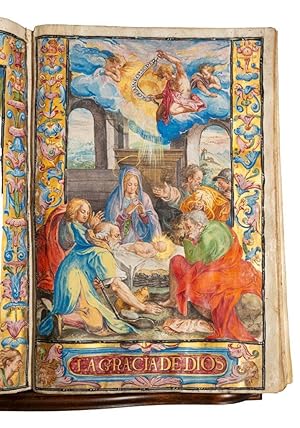
![Seller image for King Robert II of France accepts the surrender of Melun, an illuminated miniature on vellum from the Grandes Chroniques de France. [Paris, c.1400-1410] for sale by Maggs Bros. Ltd ABA, ILAB, PBFA, BA](https://pictures.abebooks.com/inventory/md/md30838712028.jpg)
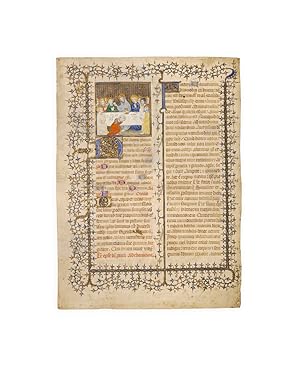
![Seller image for Undecima Asie tabula continet India extra Gange[m]. for sale by Libreria Oreste Gozzini snc](https://pictures.abebooks.com/inventory/md/md22623988900.jpg)

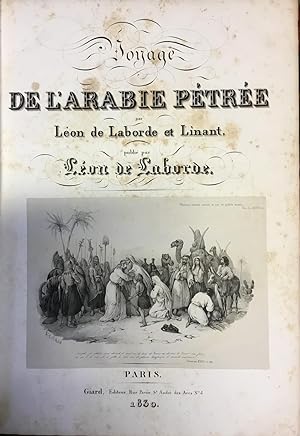
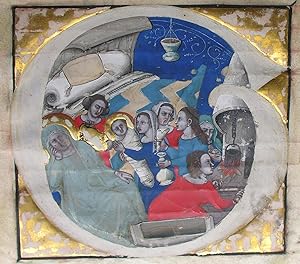
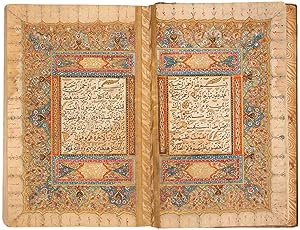
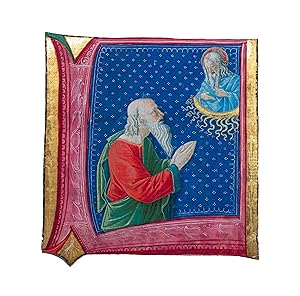
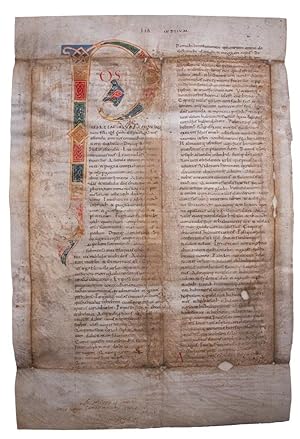

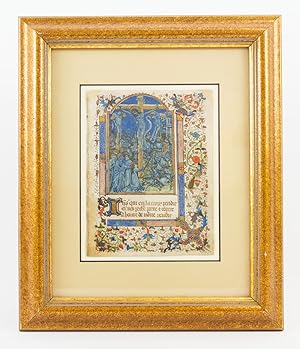
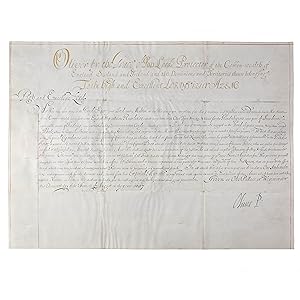
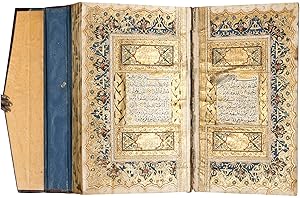
![Seller image for Masnavi-i Vamiq va 'Azra [Metiochus and Parthenope]. for sale by Antiquariat INLIBRIS Gilhofer Nfg. GmbH](https://pictures.abebooks.com/inventory/md/md31388097476.jpg)
![Seller image for [Calendrical and astrological manuscript]. for sale by Antiquariat INLIBRIS Gilhofer Nfg. GmbH](https://pictures.abebooks.com/inventory/md/md31581190427.jpg)
![Seller image for [A splendid illuminated Quran manuscript].Iran, AH 1204 [= 1783 AD]. 8vo (15 x 9 cm) Illuminated Arabic manuscript on paper, 19 lines per page, written in a neat naskh script in black ink with diacritics in red, margins ruled in gold and colours. Gold discs or florets between verses, sura headings written in white in gold cartouches flanked by panels with alternating floral motifs in gold and various colours. Brown morocco with a flap and gold-tooled borders and central ornaments. for sale by Antiquariaat FORUM BV](https://pictures.abebooks.com/inventory/md/md30708218560.jpg)
